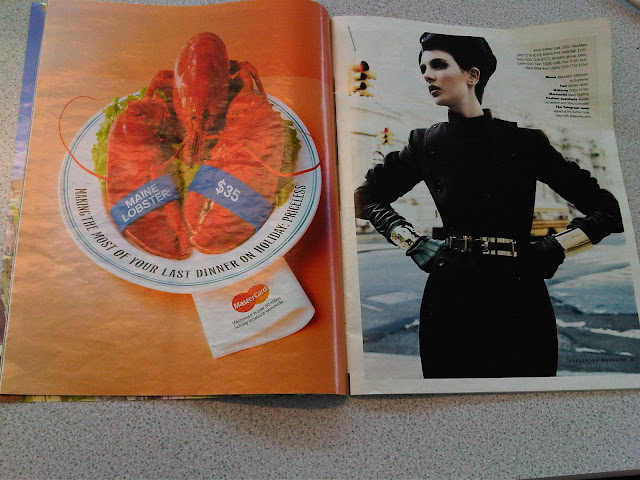For this task I am going to look at this advert for Mastercard in an edition of the Telegraph magazine. In this context, the information source is the creative concept and idea; in this case a lobster dinner being used to represent the benefits of having a Mastercard. The transmitter is the art director and graphic designers creative experience in advertising and design; layout, colour choices, choice of appropriate typography, photography skills (or appropriate choice of sourced image/photographer). The channel in this example is the media; print. The receiver is the target audience; a section of the readers of the telegraph, which in this case is fairly middle class (or aspiring middle class), predominantly women aged between around 20-45. This audience are likely to be more affluent than for example the readers of the Sun. They are likely to be more aware of advertising and the way that it works, so a more obvious less subtle advertisement would not be as successful in this context. In terms of decoding the advert, a lobster dinner is something that these readers would either relate to or wished that they could relate to, making it extremely relevant. The destination in this case is how the overall message is received. The idea that Mastercard could enable this luxury on the last day of a holiday when usually your funds are running dry is a relevant concept for this audience to relate to so I think that they would not have any immediate trouble receiving the message as it was intended. Aspects that could limit the effective communication of this advert in terms of noise could be competition; other adverts for similar products, technical issues; perhaps a printing fault or something not being proof read thoroughly (a typo), or misinterpretation via wrong context or wrong target audience; for example being put next to an article about famine in africa, or about saving your money rather than indulging in spending more than you perhaps have. I think the target audience is suited to the advertisement and could in fact suit a male or female audience. In terms of the context and placement of the advertisement, it is placed halfway through and facing some fashion photography featuring the latest trends and clothes ranging from £160-£2995. The readers of this magazine cannot necessarily afford these clothes, but they would like to think that they could aspire to afford them or at least imitate the styles, in the same way that they may not be able to afford a lobster dinner on the last day of their holiday, but they would like to should Mastercard offer that possibility.
In terms of redundancy, the advert plays on the stereotypical imagery of a lobster being associated with affluence as well as specifying that it is "Maine" lobster, a holiday destination only really visited by individuals with some amount of money. In addition to this, the strap line "Making the most of your last dinner on holiday : priceless" taps into peoples memory of all the other Mastercard adverts which feature similar tag lines. This allows the designer to place the logo in the bottom right hand corner as the target audience will almost definitely be able to make this association automatically without having it splashed across the whole page. This advert aims to be entropic by featuring mainly just an image with a small amount of text and a more subtle amount of branding, however by using the very obvious tag line and the lobster imagery it only strengthens the stereotype.


No comments:
Post a Comment